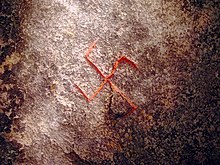Interpretatio slavica
Interpretatio slavica is the practice by the Slavic peoples to identify the gods of neighboring peoples and the names of Christian saints with the names of Slavic deities.

- Perun is a god of thunder, in functions very similar to the Germanic-Scandinavian Thor, the Baltic Perkūnas and Karelian-Finnish Ukko (the latter is of Baltic origin). Both in Germanic and in Finnish mythologies, "hatchets" were also an attribute of the Thunderer.[1] It is noteworthy that both Thor and Perun were often linked by the symbol "yarga" (the Slavic name for the four-pointed swastika), recorded by Hilda Davidson. To the Vikings the swastika could have come from the Goths or through the Baltic medium.[2]
- Stribog — resembles Latvian Žaltys, Indian god of chaos Vritra (it is noteworthy that both deities are represented in the form of chronic snake like entities or ordinary snakes). The Slavic word stryj is derived from Proto-Indo-European *stru-io- and is cognate with Lithuanian: strujus "uncle, old man" and Old Irish: sruith "old, honorable"
- Veles — considered a variant of Velnias and Germanic Frey. From the treaties of Russia with Byzantium, it is known that for the Varangian-Rus in the squad of Igor, Perun and Veles were "their own gods". It is likely that these two deities replaced the Scandinavians with their Thor and Freyr, similar in function to the Slavic deities.[3]
- Simargl — according to some scientists, it is an analog of the Iranian Simurgh,[4] although today it is widely believed that the name Simargl is a distorted phrase of "sema yerila".[5] Some researchers draw attention to the similarities between the Simargl and the fire dog Sköll, who represents the sun. The legend of eating the sun is also present from Baltic mythology.[6][7]
- Diu is a variant of the name of the ancient Zeus in the Old Russian teachings against paganism. The Russian version of the name "Zeus", according to one of the hypotheses, formed from its basis Diw.[8]
- Mokosh is an analogue of the Finno-Ugric Moksha. According to Boris Rybakov, the name of the Finnish people of the Mokshas originated from the latter.[9]
Identification with Christian saints
- Elijah the Prophet — after the baptism of Russia, he replaced Perun
- Paraskeva Friday — gradually replaced Mokosh
- Saint Blaise — replaced Volos (not to be confused with Veles, the god of wisdom and knowledge)
Identification with Christian holidays

According to a number of scientists, some native Slavic deities can be reconstructed by the names of religious (Christian) holidays which have features of paganism. Such holidays include:
According to Vladimir Toporov, it is impossible to reconstruct the Slavic gods from the names of rites and holidays, and even more so their functions.
References
- ^ It is possible that the cult of the personification of Perun with a battle axe came to the Slavs through the Scandinavian or Baltic-Finnish medium. Nikolay Makarov. Old Russian amulets-hatchets // Rossiyskaya arkheologiya. - 1992. - No. 2. - P. 41-56.
- ^ Ellis Davidson, H. R. (1965). "Thor's Hammer". Folklore. 76 (1). Taylor & Francis: 1–15. doi:10.1080/0015587X.1965.9716982. JSTOR 1258087.
- ^ Meyer E. H. Mythologie der Germanen. — Strassburg, 1903. — S. 290.
- ^ Mikhail Vasiliev. Paganism of the Eastern Slavs on the eve of the baptism of Russia. Religious and mythological interaction with the Iranian world. Moscow, 1999.
- ^ Alexander Ishutin. East Slavic gods and their names
- ^ Beresnevičius, Gintaras (2004). Lietuvių religija ir mitologija: sisteminė studija (in Lithuanian). Vilnius: Tyto alba. p. 19. ISBN 9986-16-389-7.
- ^ Jonas Trikūnas, ed. (1999). Of Gods & Holidays: The Baltic Heritage. Tvermė. pp. 75–77. ISBN 9986-476-27-5.
- ^ Diodorus of Sicily. Historical library. Book IV. Notes
- ^ Boris Rybakov. Paganism of the ancient Slavs. - M .: Nauka, 1994 .-- 608 p. - 15,000 copies. ISBN 5-02-009585-0.
- ^ Vladimir Propp. Russian agrarian holidays: (Experience of historical and ethnographic research). - Moscow: Terra, 1995. pp. 81-85
- ^ Propp, 1995, first mentioned in the exhortation of St. Tikhon of Zadonsk to the inhabitants of Voronezh, 1763;, pp. 81-85.
- ^ Propp, 1995. Russian agrarian holidays: (Experience of historical and ethnographic research). - Moscow: Terra, 1995. pp. 81-85
- ^ Vladimir Propp. Russian agrarian holidays: (Experience of historical and ethnographic research). - Moscow: Terra, 1995. p. 87
- ^ Kolyada // Mythological dictionary / Ed. by Yeleazar Meletinsky, Moscow: Sovetskaya enciklopediya, 1990. — ISBN 5-85270-068-1.












